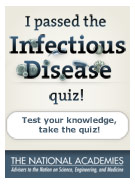
What You Need To Know About Infectious Disease
What do you know about infectious disease?
True or False: The clearing and settlement of tropical rainforests has exposed woodcutters, farmers, and ecotourists to new vector-borne diseases.
-
Correct!
The clearing and settlement of rainforests has exposed woodcutters, farmers, and ecotourists to new vector-borne diseases.
-
Sorry, that’s incorrect.
The clearing and settlement of tropical rainforests has exposed woodcutters, farmers, and ecotourists to new vector-borne diseases.
What fraction of all deaths worldwide are caused by infectious disease?
-
Sorry, that’s incorrect.
About one quarter of all deaths worldwide are caused by infectious disease. More than two-thirds of the deaths in children under the age of five are caused by infectious disease.
-
Correct!
About one quarter of all deaths worldwide are caused by infectious disease. More than two-thirds of the deaths in children under the age of five are caused by infectious disease.
-
Sorry, that’s incorrect.
About one quarter of all deaths worldwide are caused by infectious disease. More than two-thirds of the deaths in children under the age of five are caused by infectious disease.
For each child who dies from pneumonia in an industrialized country, about how many children die from the infection in developing countries?
-
Sorry, that’s incorrect.
Life-saving vaccines and medications aren’t distributed equitably around the world; for each child who dies from pneumonia in an industrialized country, more than 2,000 children die from the infection in developing countries.
-
Sorry, that’s incorrect.
Life-saving vaccines and medications aren’t distributed equitably around the world; for each child who dies from pneumonia in an industrialized country, more than 2,000 children die from the infection in developing countries.
-
Sorry, that’s incorrect.
Life-saving vaccines and medications aren’t distributed equitably around the world; for each child who dies from pneumonia in an industrialized country, more than 2,000 children die from the infection in developing countries.
-
Correct!
Life-saving vaccines and medications aren’t distributed equitably around the world; for each child who dies from pneumonia in an industrialized country, more than 2,000 children die from the infection in developing countries.
True or False: The only way public health agencies can deal with infectious disease is to have good surveillance in place, wait for an outbreak to happen in a human population, and then rush to contain it.
-
Sorry, that’s incorrect.
By identifying pathogens in the animals where they naturally live and monitoring those organisms as they move from animals into people, it may be possible to prevent deadly new infections of animal origin from entering and racing through human populations.
-
Correct!
By identifying pathogens in the animals where they naturally live and monitoring those organisms as they move from animals into people, it may be possible to prevent deadly new infections of animal origin from entering and racing through human populations.
Which of the following is a bacterial infection?
-
Sorry, that’s incorrect.
Strep throat is a bacterial infection. Hookworm is caused by a parasite and chickenpox and influenza are both caused by viruses.
-
Sorry, that’s incorrect.
Strep throat is a bacterial infection. Hookworm is caused by a parasite and chickenpox and influenza are both caused by viruses.
-
Correct!
Strep throat is a bacterial infection. Hookworm is caused by a parasite and chickenpox and influenza are both caused by viruses.
-
Sorry, that’s incorrect.
Strep throat is a bacterial infection. Hookworm is caused by a parasite and chickenpox and influenza are both caused by viruses.
Which of the following is not a viral disease:
-
Sorry, that’s incorrect.
Trichinosis is not a viral disease. It is caused by a helminth (parasitic worm) found in undercooked meat, not by a virus.
-
Sorry, that’s incorrect.
Trichinosis is not a viral disease. It is caused by a helminth (parasitic worm) found in undercooked meat, not by a virus.
-
Correct!
Trichinosis is not a viral disease. It is caused by a helminth (parasitic worm) found in undercooked meat, not by a virus.
Which reproduce the fastest:
-
Sorry, that’s incorrect.
Viruses reproduce the fastest. Humans produce a new generation every 20 years or so; bacteria do it every 20 to 30 minutes, and viruses even faster.
-
Sorry, that’s incorrect.
Viruses reproduce the fastest. Humans produce a new generation every 20 years or so; bacteria do it every 20 to 30 minutes, and viruses even faster.
-
Correct!
Viruses reproduce the fastest. Humans produce a new generation every 20 years or so; bacteria do it every 20 to 30 minutes, and viruses even faster.
Which of the following can be treated with antibiotics?
-
Sorry, that’s incorrect.
Strep throat is a bacterial infection that can be treated with antibiotics. The common cold and influenza are both viral infections, which do not respond to antibiotics. Antivirals may be prescribed instead.
-
Correct!
Strep throat is a bacterial infection that can be treated with antibiotics. The common cold and influenza are both viral infections, which do not respond to antibiotics. Antivirals may be prescribed instead.
-
Sorry, that’s incorrect.
Strep throat is a bacterial infection that can be treated with antibiotics. The common cold and influenza are both viral infections, which do not respond to antibiotics. Antivirals may be prescribed instead.
-
Sorry, that’s incorrect.
Strep throat is a bacterial infection that can be treated with antibiotics. The common cold and influenza are both viral infections, which do not respond to antibiotics. Antivirals may be prescribed instead.
Which of the following is needed to help improve the public health situation in developing countries?
- More safe water supplies
- Better sewage treatment and disposal
- Improved food safety and vaccination programs
- All of the above
-
Sorry, that’s incorrect.
All of the above are urgently needed in developing nations. A major barrier to achieving these improvements is the underlying weakness of health systems in resource-poor countries, including a shortage of health workers and a lack of disease surveillance programs.
-
Sorry, that’s incorrect.
All of the above are urgently needed in developing nations. A major barrier to achieving these improvements is the underlying weakness of health systems in resource-poor countries, including a shortage of health workers and a lack of disease surveillance programs.
-
Sorry, that’s incorrect.
All of the above are urgently needed in developing nations. A major barrier to achieving these improvements is the underlying weakness of health systems in resource-poor countries, including a shortage of health workers and a lack of disease surveillance programs.
-
Correct!
All of the above are urgently needed in developing nations. A major barrier to achieving these improvements is the underlying weakness of health systems in resource-poor countries, including a shortage of health workers and a lack of disease surveillance programs.
Thank you for taking our quiz.
Place this badge on your Facebook page to show your friends what you know about infectious disease.
Place this badge on your Facebook page to show your friends what you know about infectious disease.
OR, get a higher score to unlock a different badge.

Place this badge on your Facebook page to show your friends what you know about infectious disease.
OR, get a higher score to unlock a different badge.

Explore Other Topics
Disease Watchlist
Infectious Disease Defined
- Tissue Culture
The process by which tissues are intentionally grown under controlled conditions.


